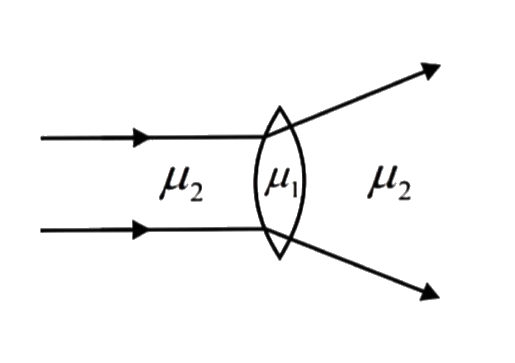An intially parallel cyclindrical beam travels in a medium of refractive index μ(I)=μ0+μ2I, where μ0 and μ2 are positive constants and I is intensity of light beam. The intensity of the beam is decreasing with increasing radius.
Answer the following questions :
The initial shape of the wavefront of the beam is
convex
concave
convex near the axis and concave near the periphery
planar
The correct Answer is:D
To solve the question regarding the initial shape of the wavefront of a cylindrical beam traveling in a medium with a varying refractive index, we can follow these steps:
1. Understanding the Beam Characteristics:
- The problem states that we have an initially parallel cylindrical beam. This means that before entering the medium, the light rays are parallel to each other and the wavefronts are uniform.
2. Identifying the Wavefront Shape:
- In optics, a wavefront is a surface over which an optical wave has a constant phase. For a parallel beam of light, the wavefronts are planar (flat) surfaces.
3. Considering the Medium:
- The refractive index of the medium is given as μ(I)=μ0+μ2I. This indicates that the refractive index depends on the intensity of the light beam, which varies with the radius from the center of the beam.
4. Effect of Refractive Index on Wavefront:
- As the beam travels through the medium, the intensity decreases with increasing radius, which suggests that the refractive index will also vary across the beam. However, this variation affects the propagation of the beam after it has entered the medium, not the initial shape of the wavefront.
5. Conclusion on Initial Wavefront Shape:
- Since the beam is initially parallel and cylindrical, the initial wavefront is planar. Thus, the answer to the question is that the initial shape of the wavefront of the beam is planar.
Final Answer:
The initial shape of the wavefront of the beam is planar.
- The problem states that we have an initially parallel cylindrical beam. This means that before entering the medium, the light rays are parallel to each other and the wavefronts are uniform.
- In optics, a wavefront is a surface over which an optical wave has a constant phase. For a parallel beam of light, the wavefronts are planar (flat) surfaces.
- The refractive index of the medium is given as μ(I)=μ0+μ2I. This indicates that the refractive index depends on the intensity of the light beam, which varies with the radius from the center of the beam.
- As the beam travels through the medium, the intensity decreases with increasing radius, which suggests that the refractive index will also vary across the beam. However, this variation affects the propagation of the beam after it has entered the medium, not the initial shape of the wavefront.
- Since the beam is initially parallel and cylindrical, the initial wavefront is planar. Thus, the answer to the question is that the initial shape of the wavefront of the beam is planar.
The initial shape of the wavefront of the beam is planar.
Topper's Solved these Questions
Similar Questions
An intially parallel cyclindrical beam travels in a medium of refractive index μ(I)=μ0+μ2I, where μ0 and μ2 are positive constants and I is intensity of light beam. The intensity of the beam is decreasing with increasing radius.
Answer the following questions :
The speed of light in the medium is
View SolutionAn intially parallel cyclindrical beam travels in a medium of refractive index μ(I)=μ0+μ2I, where μ0 and μ2 are positive constants and I is intensity of light beam. The intensity of the beam is decreasing with increasing radius.
Answer the following questions :
As the beam enters the medium, it will
View SolutionRefractive index mu is given as μ=A+Bλ2, where A and B are constants and lambda is wavelength, then dimensions of B are same as that of
View SolutionRefractive index mu is given as μ=A+Bλ2, where A and B are constants and lambda is wavelength, then dimensions of B are same as that of
View SolutionA biconvex thin lens is prepared from glass of refractive index μ2=32. The two conducting surfaces have equal radii of 20 cm each. One of the the surface is silvered from outside to make it reflecting. It is placed in a medium of refractive index μ1=53. It acts as a
View SolutionA thin lens made of a material of refractive indexμ2 has a medium of refractive index μ1 on one side and a medium of refractive index on the other side. The lens is biconvex and the two radii of curvature have equal magnitude R. A beam of light travelling parallel to the principal axis is incident on the lens. Where will the image be formed if the beam is incident from (a) the medium p, and (b) from the medium μ3?
View SolutionTwo parallel rays are travelling in a medium of refractive index μ1=4/3. One of the rays passes through a parallel glass slab of thickness t and refractive index μ2=3/2. The path difference between the two rays due to the glass slab will be
View SolutionRefractive index of the material of concave lens is μ. The lens is immersed inb a medium of refractive index μ1(μ1>μ). A parallel beam of light is incident on the lens. Draw a diagram to show the path of emergent rays.
View SolutionA thin bi-convex lens made out of a material of refractive index μ1 is place in a medium of refractive index μ2. A paraxial beam of light, parallel to the principal axis of the lens, is shown in the figure. Based on the ray diagram, we can conclude that

View SolutionTwo coherent light beams of intensities I and 4I produce interference pattern. The intensity at a point where the phase difference is zero, will b:
View Solution
